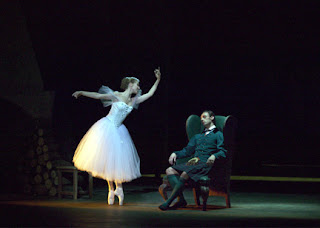As my time in Denmark draws to a close, I was
pleased to have the opportunity to see the whole of ‘La Bayadère’ having previously only seen the last section, ‘The
Kingdom of the Shades’. La Bayadère
is one of the 19th century classic ballets choreographed by Marius
Petipa, with music by Minkus. It was
first performed in 1877 at the Mariynsky Theatre in St Petersburg. It is typical of its era, with an exotic
setting, dramatic story, love, myth and the opportunity for sumptuous costumes
and scenery.
The ballet tells the story of the bayadère or temple dancer Nikiya and the
warrior Solor who are in love. However,
the High Brahmin is also in love with her.
Meanwhile, the Rajah Dugmanta of Golconda has chosen Solor to be
the fiancé of his daughter Gamzatti. It all then becomes complicated, as these
things tend to, but to sum up the plot quickly, Gamzatti decides that Nikiya
must die. During the betrothal
celebrations (where we have lots of variations and opportunities for dancers to
show off), Nikiya is given a basket of flowers, which she believes are from
Solor. However, they are from the Rajah
and Gamzatti who have hidden a poisonous snake in it, which of course pops out
and bites her on the neck. Nikiya
declines the offer of an antidote and dies.
The final act sees Solor smoking opium and dreaming of being reunited
with his true love in The Kingdom of the Shades.
This production for the Royal Danish Ballet was
staged by Nikolaj Hübbe and Eva Draw. In
this version, the story has been moved to the end of the 19th
century during the British Raj. As a
result, there are some changes to the main characters: the Rajah Dugmanta becomes the
British vice-consul, Lord Ashbury, and so his daughter becomes Lady Emma and
the warrior Solor becomes a British officer by the name of Sir William
Sibley. Thus we had British soldiers in
shorts and topees at one point, and even a Union Jack on an elephant.
We saw
Gudrun Bojesen and Marcin Kupinski in the main roles. Bojesen is a beautiful
and lyrical dancer with lovely clear lines and made, in my opinion at least, a
very good Nikiya. I was pleased that it
was Kupinski that we saw, since I have a problem with the undoubtedly strong,
but with a footballers physique and no personality, Alban Lendorf. Kupinski is a fine dancer but I agree with
one review I read that felt he struggled to keep up the strength for such a
role. However, he looked so good in the
part and was as light as a feather and looked the romantic hero. As usual, there were some ‘corps
irregularities’, but the company has improved a lot in this area in the past
year or so.
Gudrun Bojesan as Nikija
The
costumes were wonderful and a real riot of contrasting colours. The sets too were evocative, and the
appearance of an elephant (not real I hasten to add!) added a touch of
humour. Naturally, there was also a
chorus of children, the boys’ costumes transforming them into mini peacocks.
All in
all I enjoyed the evening, though it was a long one (3 hours including 2
intervals). This is a ballet that should
have a firm place in the company’s repertoire.
It suits the pure classical style of the dancers much more than some
more contemporary pieces. If you get a
chance, see it. Definitely one I would
highly recommend.
Bojesen and Kupinski












